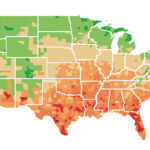One of the most pressing issues currently facing global communities is climate change. The United States, being one of the world’s leading greenhouse gas emitters, has a heavy responsibility in defining global climate policies. U.S. policy regarding climate change has significantly evolved, varying with the administration. This article explores the stance of the U.S. toward initiatives of climate change by analysing policies and strategies under different administrations as well as their impacts on both domestic and international efforts in fighting global warming.
1. The Obama Administration (2009-2017): Pushing for Global Leadership
Under President Barack Obama, the United States adopted a proactive role for itself on climate change, hence becoming a world leader in the course of events to come. Another of the hallmark policies was reducing carbon emissions with its Clean Power Plan and encouraging renewable energy technologies. The greenhouse gas reduction target from U.S. emissions was set at 26-28% below 2005 levels by 2025.
Obama’s efforts led to an international agreement signed in 2015-the Paris Agreement. It aimed to keep the global rise from pre-industrial levels as low as possible at well below 2°C and pursuing efforts to limit it to 1.5°C. United States is one of the chief negotiating and shaper countries of the new treaty, expressing a commitment to reduction of emissions while ensuring climate finance for developing countries. The Paris Agreement was considered a defining moment in global climate diplomacy, in large part because of the United States’ strong engagement.
2. The Trump Administration (2017-2021): A Step Back from Global Engagement
Donald Trump’s inauguration in the White House represented a stark turn in climate policy from the United States. Vocal climate change skeptic Donald Trump pulled America out of the Paris Agreement in 2017, citing an economic burden on the country. It was a significant setback for international climate efforts since America played a key role in the agreement’s creation. Trump’s administration focused on rolling back environmental regulations, such as the Clean Power Plan, and promoted the expansion of fossil fuel industries, including coal and oil.
Under the leadership of Trump, climate change was no longer a national security threat; the administration was greatly criticized for their lack of action in environmental protection. Some states and cities like California and New York, however, continued to push forward with their own climate initiatives, filling the gap that the federal policy left behind.
3. The Biden Administration: Renewed Commitment to Climate Action (2021-Present)
With the election of Joe Biden in 2020, climate change once again became a central focus of U.S. policy. On his first day in office, Biden rejoined the Paris Agreement, signaling the U.S.’s return to international climate leadership. The Biden administration’s climate agenda has been ambitious, with plans to cut greenhouse gas emissions by 50-52% by 2030 and achieve net-zero emissions by 2050.
Thus, both at home and abroad, actions are Biden’s focus. Domestically, his administration seeks investments in the green energy sector while promoting actions like the American Jobs Plan, which goes hand in hand with incentives in clean energy, electric vehicles, and infrastructure improvement. Furthermore, Biden’s Build Back Better Act proposed a massive amount for climate initiatives, although the bill had challenges in Congress.
Internationally, the Biden Administration has once again attempted to reassert the U.S. leadership role in climate diplomacy. In 2021, he conducted the Leaders Summit on Climate, with 40 world leaders, including China’s Xi Jinping and Russia’s Vladimir Putin, discussing ways to accelerate global climate action. Emphasis for developed nations and their responsibility in fulfilling the climate finance obligation will support developing countries in their climate transitions.
Conclusion: The U.S. and the Future of Climate Action
The United States has experienced different stages in its handling of climate change-from active engagement and leadership under Obama, retreat under Trump, to renewed commitment under Biden. Each administration’s policy has molded the role of the U.S. in global climate action, with profound implications for the world at large.
While the Biden administration thus continues to implement ambitious climate policies, the U.S. today faces the dual challenge of squaring domestic political divisions with an active role in international climate cooperation. Success here will decide not only the fate of the U.S.’s environmental policies but also the fate of the world’s struggle against climate change.

Posted inGeneral
